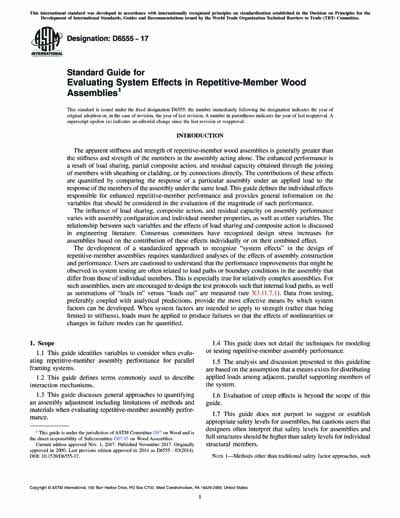Historical
ASTM D6555-17
Standard Guide for Evaluating System Effects in Repetitive-Member Wood Assemblies
1.1 This guide identifies variables to consider when evaluating repetitive-member assembly performance for parallel framing systems.
1.2 This guide defines terms commonly used to describe interaction mechanisms.
1.3 This guide discusses general approaches to quantifying an assembly adjustment including limitations of methods and materials when evaluating repetitive-member assembly performance.
1.4 This guide does not detail the techniques for modeling or testing repetitive-member assembly performance.
1.5 The analysis and discussion presented in this guideline are based on the assumption that a means exists for distributing applied loads among adjacent, parallel supporting members of the system.
1.6 Evaluation of creep effects is beyond the scope of this guide.
1.7 This guide does not purport to suggest or establish appropriate safety levels for assemblies, but cautions users that designers often interpret that safety levels for assemblies and full structures should be higher than safety levels for individual structural members.
Note 1: Methods other than traditional safety factor approaches, such as reliability methods, are increasingly used to estimate the probability of failure of structural elements. However, the extension of these methods to assemblies or to complete structures is still evolving. For example, complete structures will likely exhibit less variability than individual structural elements. Additionally, there is a potential for beneficial changes in failure modes (i.e., more ductile failure modes in systems). These considerations are beyond the scope of this guide.
1.8 The values stated in inch-pound units are to be regarded as the standard. The SI equivalents are approximate in many cases.
1.9 This standard does not purport to address all of the safety concerns, if any, associated with its use. It is the responsibility of the user of this standard to establish appropriate safety and health practices and determine the applicability of regulatory limitations prior to use.
1.10 This international standard was developed in accordance with internationally recognized principles on standardization established in the Decision on Principles for the Development of International Standards, Guides and Recommendations issued by the World Trade Organization Technical Barriers to Trade (TBT) Committee.
Content Provider
ASTM International [astm]






